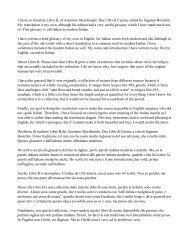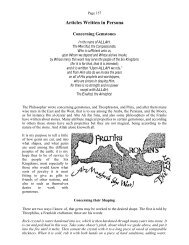How to Milk an Almond Stuff an Egg And Armor a Turnip A ...
How to Milk an Almond Stuff an Egg And Armor a Turnip A ...
How to Milk an Almond Stuff an Egg And Armor a Turnip A ...
You also want an ePaper? Increase the reach of your titles
YUMPU automatically turns print PDFs into web optimized ePapers that Google loves.
151<br />
intensive dishes th<strong>an</strong> you have labor? <strong>How</strong> expensive are the ingredients? Once you have the<br />
menu worked out you will do detailed calculations <strong>to</strong> <strong>an</strong>swer these questions, but it is useful <strong>to</strong><br />
keep them in the back of your mind while designing the menu.<br />
The third consideration is qu<strong>an</strong>tity. If you are serving eight main dishes, your guest does not<br />
have <strong>to</strong> make a full meal out of each of them. Our rule of thumb is <strong>to</strong> allow a <strong>to</strong>tal of half a pound<br />
of meat per person. That me<strong>an</strong>s that for every dish you estimate the <strong>to</strong>tal amount of meat,<br />
including fish <strong>an</strong>d fowl <strong>an</strong>d not counting fat, bones, or skin, add it up for all the dishes <strong>an</strong>d divide<br />
by the number of people. If you have a lot of bulky non-meat dishes–soups or pies thickened with<br />
egg <strong>an</strong>d cheese, for example–you might w<strong>an</strong>t <strong>to</strong> reduce the <strong>to</strong>tal <strong>to</strong> a third of a pound. If you are<br />
not certain how m<strong>an</strong>y guests will show up, you may w<strong>an</strong>t <strong>to</strong> make contingency pl<strong>an</strong>s—ways of<br />
exp<strong>an</strong>ding or contracting your feast at the last minute.<br />
You now have a tentative menu. Next you will w<strong>an</strong>t <strong>to</strong> work out a set of detailed pl<strong>an</strong>s<br />
showing what is done when <strong>an</strong>d how much it all costs. One convenient way of doing this is <strong>to</strong> use<br />
time lines. Make a list of all the fixed resources that you are afraid you may not have enough of–<br />
ovens, burners, large pots, electric frying p<strong>an</strong>s. List them down the left side of a sheet of graph<br />
paper. Across the <strong>to</strong>p of the sheet mark the time, starting whenever you pl<strong>an</strong> <strong>to</strong> start cooking <strong>an</strong>d<br />
ending when the last dish is served. Draw a horizontal line for each item. Mark on that line what<br />
the item is being used for at each time. The result (for a few items <strong>an</strong>d a few dishes) will look<br />
something like:<br />
Burner 1<br />
Burner 2<br />
Oven 1<br />
10 gallon pot<br />
10 gallon pot<br />
5 gallon pot<br />
Lge Frying p<strong>an</strong><br />
1:00 2:00 3:00 4:00 5:00 6:00<br />
Meat Pottage<br />
Bur<strong>an</strong>(eggpl<strong>an</strong>t)<br />
Bur<strong>an</strong>(eggpl<strong>an</strong>t)<br />
Meat Pottage<br />
Bur<strong>an</strong>(eggpl<strong>an</strong>t)<br />
Piecrusts<br />
Bur<strong>an</strong>(eggpl<strong>an</strong>t)<br />
Bur<strong>an</strong>(meatballs)<br />
Spinach-Cheese Pies<br />
Meat Pottage<br />
Bur<strong>an</strong>(meatballs)<br />
To make sense of the diagram, start with the meat pottage (recipe on p. 22). It occupies a 10<br />
gallon pot from 2:00 until 6:30, when it will be served. The first stage in cooking it is <strong>to</strong> boil the<br />
meat; this is done on burner 1 from 2:00 <strong>to</strong> 3:00. The pottage is then taken off the burner, which<br />
is then free <strong>to</strong> be used for something else. The meat is taken out of the broth, cut up, <strong>an</strong>d put back<br />
in along with beef broth, bread crumbs, <strong>an</strong>d spices. At 5:30 the pot goes back on the s<strong>to</strong>ve, this<br />
time on burner 2 (burner 1 is by that time being used for something else) <strong>an</strong>d is brought <strong>to</strong> a boil;<br />
the rest of the ingredients (chopped parsley, grated cheese, <strong>an</strong>d eggs) are stirred in.<br />
Starting at 2:20, the second 10 gallon pot is used on burner 2 <strong>to</strong> boil the eggpl<strong>an</strong>t which is one<br />
of the ingredients of bur<strong>an</strong>, a medieval Islamic dish (p. 90). After that is finished, a 5 gallon pot<br />
Rice<br />
Rice





